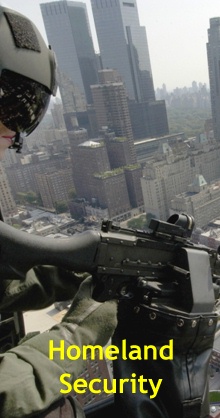|
Key findings of the report:
-
Among driving forces in the international security environment
affecting the potential future use of Weapons of Mass Destruction (WMD) against the Unites States, those judged to be the
most significant are the spread of radical Islam and the increase of globalization.
-
Plausible events could lead to alternative futures in
which radical Islam and globalization could be either high or low.
-
The likelihood of the use of WMD would be highest in
the Hidden Islam scenario and lowest in the Open Borders scenario.
-
Each scenario has different opportunities, allies, threats
and competitors.
-
In all scenarios, there are indicators and signposts
that occur in the years prior to their full development that the intelligence community will be tasked to monitor and identify.
DOWNLOAD THE REPORT
According to the book description of
Weapons of Mass Destruction and Terrorism, “Brigadier General (Retired) Russell Howard and
Dr. James Forest have collected original and previously published seminal articles and essays by scientists, academics, government
officials, and members of the nation’s security and intelligence communities. The editors and several of the authors
write from practical field experience in nonproliferation and counterterrorism efforts. Others have had significant responsibility
for developing government policies to address the threat of weapons of mass destruction and terrorism. The contributors include
a majority of the significant names in the field including Bruce Hoffman, Brian Jenkins, Jonathan Tucker, Rohan Gunaratna,
David Franz, Richard Betts, William Rosenau, and David Albright.
Unit One of the book introduces key terms and addresses important strategic
and policy debates. Authors explain how the new forms of terrorism affect the post-9/11 security environment and introduce
the notion that weapons of mass destruction could give terrorists short-term, asymmetric attack advantages over conventional
military forces. Unit Two offers detailed accounts of the characteristics, availability, and dangers of specific types of
WMD, along with four case studies that associate theory with practice an important feature of this volume. Unit Three deals
with past, present, and future national and international responses to and defenses against the threat of WMD terrorism. And
in the final section of the volume, authors predict future WMD threats and seek to draw on past events and mistakes in order
to identify lessons and strategies for the future.
Appendices include a primer on bioterrorism
and fact sheets on chemical, biological, nuclear and radiological terrorism. Brigadier General (retired) Russell Howard, a
career Special Forces officer, is the former Head of the Department of Social Sciences at the U.S. Military Academy. He has
had numerous antiterror and counterterror responsibilities and has taught and published books and articles on terrorism subjects..
. James Forest is the Director of Terrorism Studies and Assistant Professor of Political Science at the U.S. Military Academy.
His teaching, research and publications focus on terrorist recruitment and training.. . Major Joanne Moore is a career Army
officer, currently serving in Iraq. Until recently, she served as an assistant professor of political science at the U.S.
Military Academy, teaching courses on American politics and homeland security.”
According to the book description of International Law and the Proliferation
of Weapons of Mass Destruction, “Proliferation of WMD technologies is by no means a new concern for the
international community. Indeed, since the signing of the Nuclear Non-proliferation Treaty in 1968, tremendous energies have
been expended upon diplomatic efforts to create a web of treaties and international organizations regulating the production
and stockpiling of WMD sensitive materials within states, as well as their spread through the increasingly globalized channels
of international trade to other states and non-state actors.
However, the intervention in 2003 by Western powers in Iraq has served as an illustration
of the importance of greater understanding of and attention to this area of law, as disagreements over its content and application
have once again lead to a potentially destabilizing armed intervention by members of the United Nations into the sovereign
territory of another member state. Other ongoing disputes between states regarding the character of obligations work assumed
under non-proliferation treaty instruments, and the effect of international organizations' decisions in this area, form
some of the most contentious and potentially destabilizing issues of foreign policy concern for many states.
This book provides a comprehensive
analysis of international law and organizations in the area of WMD proliferation. It will serve both as a reference for understanding
the law as it currently exists in its political and economic context, as well as an analysis of areas in which amendments
to existing law and organizations are needed.”
|
